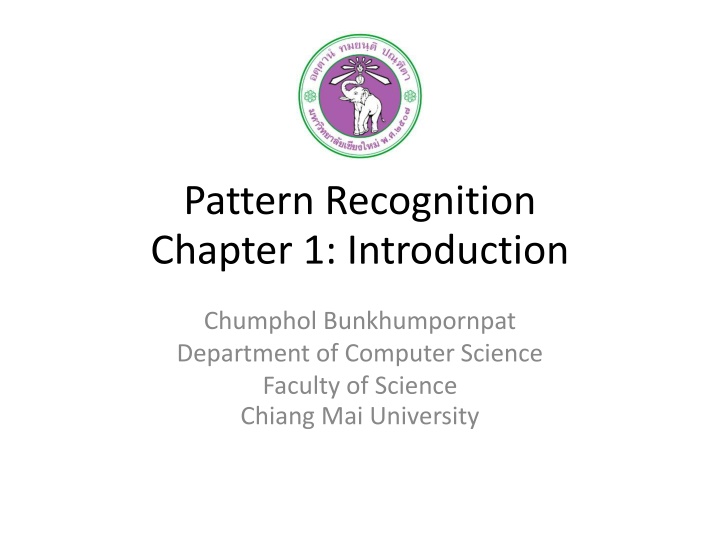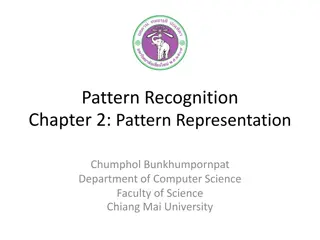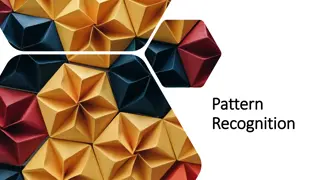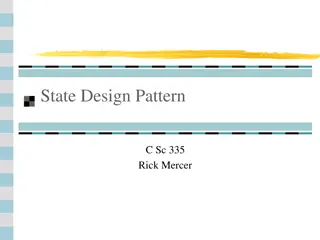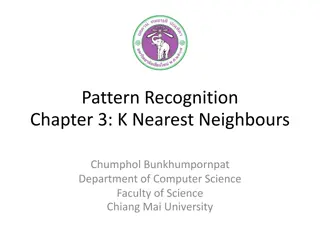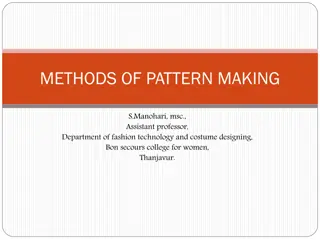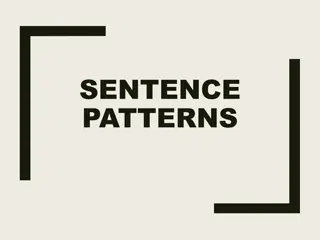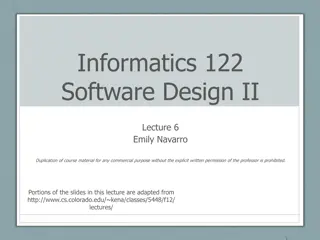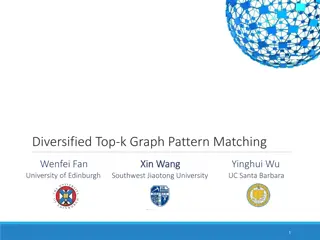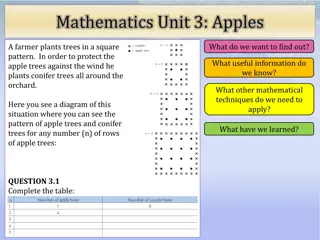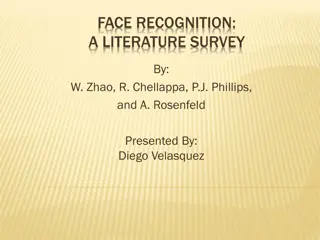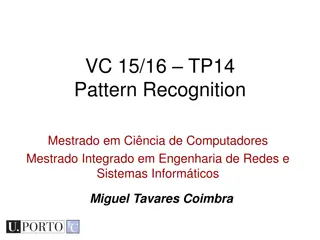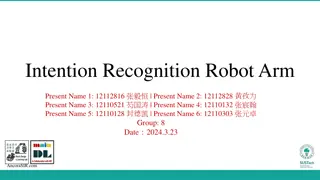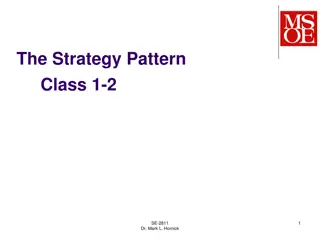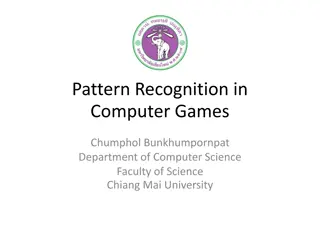Introduction to Pattern Recognition: Importance & Applications
Pattern recognition involves classifying data based on statistical information extracted from patterns. This chapter covers the definition of pattern recognition, its significance in various applications, and explores Multimedia Document Recognition (MDR) where text, audio, and video data are analyzed. Examples include identifying criminals based on multimedia data such as fingerprints, faces, and speech. Pre-processing of data is also discussed to convert raw data into machine-friendly formats.
Download Presentation

Please find below an Image/Link to download the presentation.
The content on the website is provided AS IS for your information and personal use only. It may not be sold, licensed, or shared on other websites without obtaining consent from the author.If you encounter any issues during the download, it is possible that the publisher has removed the file from their server.
You are allowed to download the files provided on this website for personal or commercial use, subject to the condition that they are used lawfully. All files are the property of their respective owners.
The content on the website is provided AS IS for your information and personal use only. It may not be sold, licensed, or shared on other websites without obtaining consent from the author.
E N D
Presentation Transcript
Pattern Recognition Chapter 1: Introduction Chumphol Bunkhumpornpat Department of Computer Science Faculty of Science Chiang Mai University
Learning Objectives Be able to define pattern recognition Understand its importance in various applications Be able to explain the two main paradigms for pattern recognition problems 2 204453: Pattern Recognition
What is Pattern Recognition? Pattern recognition can be defined as the classification of data based on knowledge already gained or on statistical information extracted from patterns and/or their representations. 3 204453: Pattern Recognition
Multimedia Document Recognition (MDR) We have to deal with a combination of text, audio and video data. The text data may be made up of alpha-numerical characters corresponding to one or more natural language. The audio data could be in the form of speech or music. The video data could be a single image or a sequence of images. 4 204453: Pattern Recognition
MDR (cont.) The face of a criminal, his fingerprint and signature could come in the form of a single image. It is also possible to have a sequence of images of the same individual moving in an airport in the form of a video clip. 5 204453: Pattern Recognition
MDR (cont.) Based on the multimedia data of an individual, in the form of fingerprints, face and speech, we can decide whether he is a criminal or not. 6 204453: Pattern Recognition
Pre-Processing of Data In a typical pattern recognition application, we need to process the raw data and convert it into a form that is amenable for a machine to use. 7 204453: Pattern Recognition
Pre-Processing of Data (cont.) It may be possible to convert all forms of a multimedia data into a vector of feature values. 8 204453: Pattern Recognition
Example Set of Patterns 9 204453: Pattern Recognition
Example Set of Patterns (cont.) There are patterns of Class X and Class O. Pattern P is a new sample which has to be assigned either to Class X or Class O. 10 204453: Pattern Recognition
Example Set of Patterns (cont.) In a system that is built to classify humans into tall, medium and short, the abstractions, learnt from examples, facilitate assigning one of these class labels ( tall , medium or short ) to a newly encountered human. 11 204453: Pattern Recognition
Classification of Humans into Group tall or short Using Feature weight 12 204453: Pattern Recognition
Classification of Humans into Group tall or short Using Feature weight (cont.) A pattern is represented as a vector of feature values. Consider the data shown in the table where humans are to be categorised into two groups tall and short . 13 204453: Pattern Recognition
Classification of Humans into Group tall or short Using Feature weight (cont.) The classes are represented using feature weight . If a newly encountered person weighs 46 kg, then he/she may be assigned the class label short because 46 is closer to 50. 14 204453: Pattern Recognition
Classification of Humans into Group tall or short Using Feature weight (cont.) However, such an assignment does not appeal to us because we know that the weight of an individual and the class labels tall and short do not correlate well; a feature such as height is more appropriate. 15 204453: Pattern Recognition
Machine Learning Repository at UC Irvine www.ics.uci.edu/MLRepository.html It contains a number of data sets of varying sizes which can be used by any classification algorithms. 16 204453: Pattern Recognition
Machine Learning Repository at UC Irvine (cont.) Many of them even give the classification accuracy for some classification methods which can be used as a benchmark by researchers. 17 204453: Pattern Recognition
Weka 18 204453: Pattern Recognition
Different Paradigms for Pattern Recognition Statistical Pattern Recognition Syntactic Pattern Recognition 19 204453: Pattern Recognition
Statistical Pattern Recognition Most practical problems in this area deal with noisy data and uncertainty statistics and probability are good tools to deal with such problems. 20 204453: Pattern Recognition
Syntactic Pattern Recognition Formal language theory provides the background for this area and systems based on such linguistic tools are not ideally suited to deal with noisy environments. 21 204453: Pattern Recognition
Vector Space We use vector spaces to represent patterns and classes. The abstractions typically deal with probability density/distributions of points in multi- dimensional spaces. 22 204453: Pattern Recognition
Vector Space (cont.) Because of the vector space representation, it is meaningful to talk of sub-spaces/projections and similarity between points in terms of distance measures. 23 204453: Pattern Recognition
Reference Murty, M. N., Devi, V. S.: Pattern Recognition: An Algorithmic Approach (Undergraduate Topics in Computer Science). Springer (2012) Witten, I. H., Frank, E., Hall, M. A.: Data Mining: Practical Machine Learning Tools and Techniques, 3rd Edition. Morgan Kaufman (2011) 24 204453: Pattern Recognition
